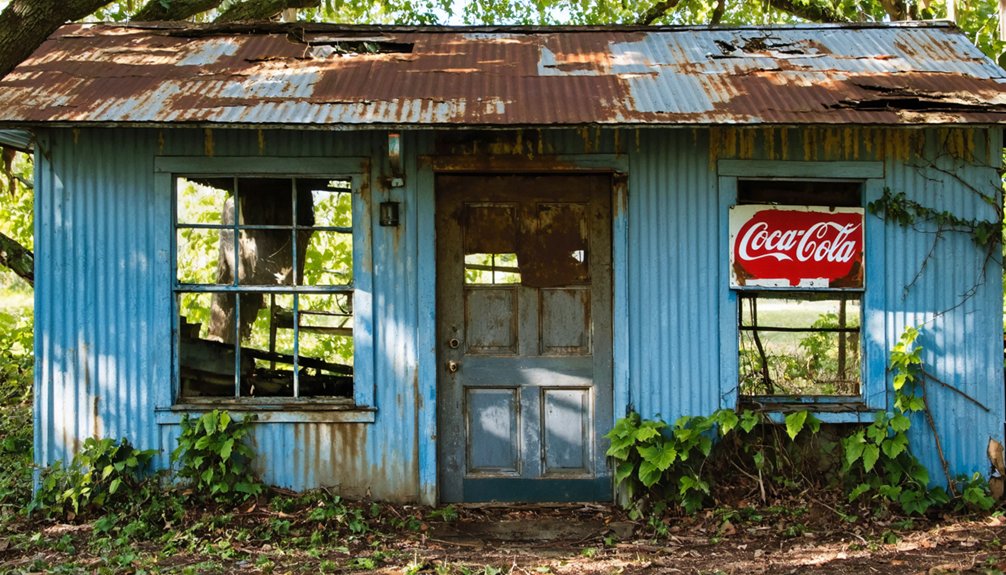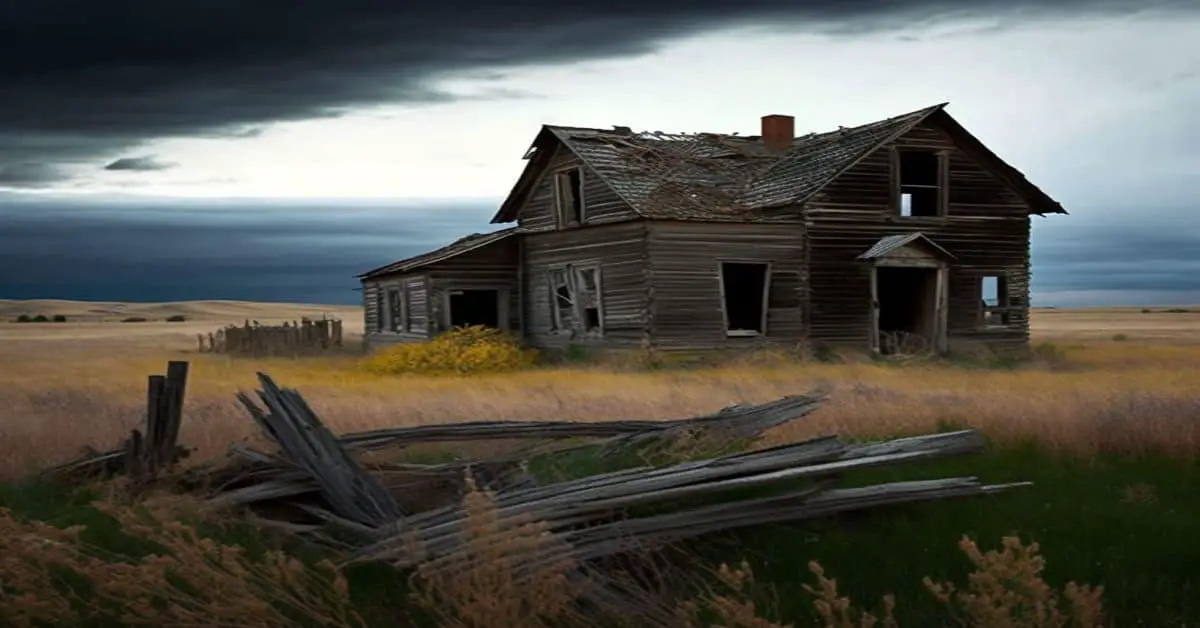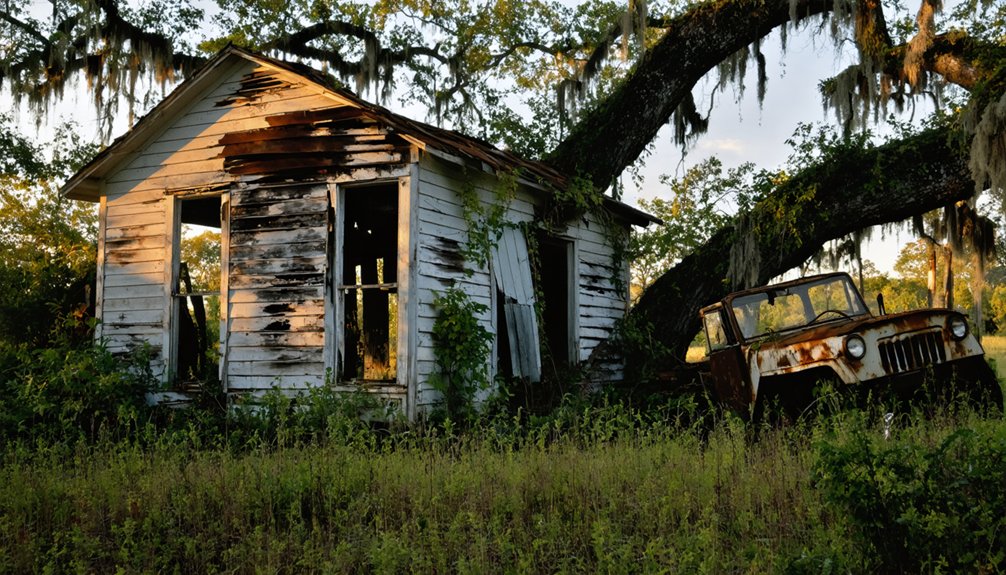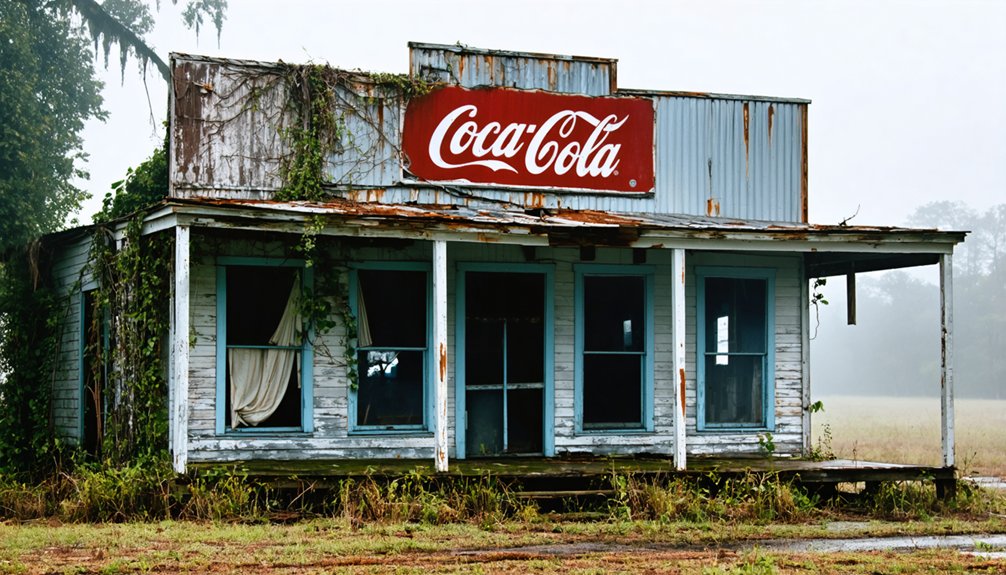You’ll discover Laurel Valley Village along Louisiana Highway 308, America’s most complete surviving 19th-century sugar plantation complex. Established in 1785 by Etienne Boudreaux, it grew into Louisiana’s largest sugar plantation with nearly 40 original structures still standing today. From the preserved slave quarters to the historic sugar mill, these buildings tell stories of brutal working conditions, agricultural innovation, and cinematic history. The site’s dark past and reported paranormal activity continue to intrigue visitors.
Key Takeaways
- Laurel Valley Village stands as one of the largest surviving 19th-century sugar plantations, with nearly 40 original historic buildings still intact.
- Founded in 1785 by Etienne Boudreaux, the village evolved from a subsistence farm into the South’s largest sugar plantation.
- The site features preserved structures including slave quarters, a historic schoolhouse, and a sugar mill that attracts film productions.
- Local folklore includes reported ghost sightings of former slaves and Civil War soldiers, particularly near the sugar mill and quarters.
- The village has become a popular filming location, featured in major productions like “Interview with the Vampire” and “The Highwaymen.”
The Historical Roots of Laurel Valley Village
When Etienne Boudreaux acquired a Spanish land grant in 1785, he established what would become Laurel Valley Village along Bayou Lafourche, a former main branch of the Mississippi River.
You’ll find deep roots of Cajun culture here, as French Acadians settled the area after their expulsion from Nova Scotia, bringing their rich Acadian heritage to southern Louisiana. The Boudreaux family focused on subsistence farming, growing various crops to sustain their household.
The settlement’s strategic location offered natural advantages, with fertile alluvial soil enriched by annual flooding cycles, making it perfect for agriculture. Today, it stands as the largest sugar plantation in the South, preserving its historical significance.
Named for its abundant laurel oak trees, the village grew considerably after 1832 when Joseph Tucker purchased the property from the Boudreaux family.
Tucker’s vision transformed the settlement by building a sugar mill and expanding operations, setting the foundation for what would become a thriving agricultural community.
Life on a Louisiana Sugar Plantation
You’d find plantation workers rising before dawn to begin their grueling daily routines of tending sugarcane fields and operating the steam-powered mills that processed the harvest.
Throughout the year, workers followed a strict agricultural calendar that included planting in spring, maintaining crops through summer, and conducting an intensive harvest season in November when the mills ran day and night. Planters often implemented shift work operations to maintain continuous production during peak processing times.
The demanding work cycle required specialized skills, from field cultivation to industrial processing, with enslaved laborers performing tasks ranging from cutting and hauling cane to operating complex machinery in the sugar house. Workers faced constant danger as they handled the boiling cane juice in the Jamaica Train system.
Daily Plantation Worker Life
Life on Louisiana sugar plantations represented one of the harshest forms of agricultural slavery in the American South. You’d find yourself working in brutal shifts lasting up to 12 hours, day and night, under a strict labor hierarchy of overseers and drivers. The labor force was organized into three distinct gangs based on age and physical capability.
During grinding season, many slaves endured two eight-hour shifts to keep the mills operating continuously. Daily routines involved backbreaking tasks from dawn to dusk: cutting cane, weeding fields, hunting rats, maintaining equipment, and processing sugar in dangerous mill conditions.
Working conditions were lethal, with high mortality rates from tropical diseases, accidents with grinding machinery, and extreme physical exhaustion. You’d live in overcrowded cabins, facing constant surveillance and the threat of severe punishment for any perceived infractions.
Even after emancipation, the cycle continued through sharecropping and plantation store debt, keeping workers economically enslaved for generations.
Sugar Production Work Cycle
Operating a Louisiana sugar plantation demanded precise timing and coordination across vast agricultural complexes, where success hinged on mastering both natural growing cycles and industrial processing demands.
You’d find sugarcane cultivation requiring a strict 10-month growing season, with frost-free conditions critical for ideal sucrose content. Labor management meant coordinating hundreds of workers across multiple tasks, from maintaining extensive levee systems to operating steam-powered mills that couldn’t stop once harvest began. After the decline of indigo from insects, plantation owners transitioned to sugar cane cultivation as their primary crop. The Louisiana Sugar Planters Association played a crucial role by promoting scientific production methods that revolutionized the industry.
- Field operations required military-like precision, with gang labor organized in shifts to handle planting, weeding, and harvesting.
- Mill workers needed specialized skills to process cane immediately after cutting, keeping the industrial machinery running constantly.
- Success depended on careful timing between field operations and mill processing, with no room for delays that could ruin an entire harvest.
Architectural Legacy and Preserved Structures
The architectural legacy of Laurel Valley Village stands as one of Louisiana’s most extensive collections of preserved 19th and 20th-century structures, featuring nearly 40 original buildings that showcase Acadian, Creole, and immigrant influences.
You’ll find unique adaptations to the local climate, including raised foundations that have enhanced the architectural significance of these historic structures through the years.
Among the preserved buildings, you can explore authentic slave quarters, a relocated general store, a historic schoolhouse, and an 1850s sugar mill complex with its towering exhaust stack.
The site’s historical significance was shaped by Joseph W. Tucker’s ownership in 1832, which transformed it into one of the South’s largest sugar plantations.
Visitors must book tours online at least 48 hours before their planned visit to explore these remarkable structures.
The Laurel Valley Heritage Foundation maintains these structures’ historical integrity through careful restoration, while the site’s preservation challenges are met through tourism revenue and community support.
As a National Register historic district, it’s become a model for industrial site preservation.
From Working Village to Heritage Site
While sugarcane production remained Laurel Valley’s economic backbone through the late 19th and early 20th centuries, this working plantation gradually transformed into a heritage destination under the Lepine family’s stewardship.
You’ll find a remarkable heritage transformation that preserved both agricultural traditions and cultural history, with the site’s listing on the National Register of Historic Places in 1978 marking a pivotal moment in its evolution.
- The village’s community resilience is evident in the preservation of 60 original structures from a once-thriving population of 450 workers.
- You’ll discover a unique blend of active farming operations alongside educational and cultural preservation efforts.
- The site now showcases the complex interactions between diverse ethnic groups, including African Americans, Acadians, Creoles, and immigrant workers.
Hollywood’s Southern Backdrop
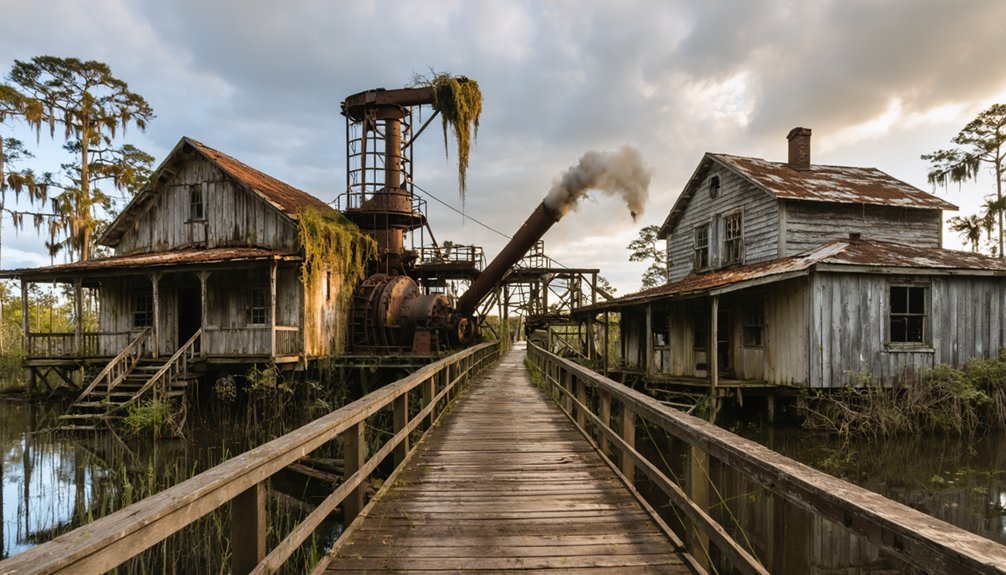
Since its emergence as a premier filming location, Laurel Valley Village has captivated Hollywood directors with its authentic Southern atmosphere and preserved historical structures.
You’ll find evidence of its rich cinematic history in films like “Angel Heart” (1987), “Interview with the Vampire” (1994), and the Oscar-winning “Ray” (2004).
The village’s over 50 original buildings, including slave cabins, sugarcane fields, and a historic church, provide film productions with genuine period settings that would be costly to recreate on studio lots.
From supernatural thrillers to biographical dramas, Laurel Valley’s versatile landscape continues to serve as an authentic backdrop for Southern Gothic tales and historical narratives, most recently seen in Netflix’s “The Highwaymen” (2019), which captured the village’s preserved 1930s aesthetic.
Tales and Legends of the Village
You’ll find Laurel Valley Village’s darkest stories in the accounts of shadowy figures spotted near the former slave quarters and sugar mill after sunset.
Local folklore attributes these sightings to the spirits of enslaved workers and Civil War soldiers, though paranormal investigators haven’t confirmed these claims.
The village’s oral histories preserve accounts from former residents who worked the sugarcane fields, adding historical weight to tales of mysterious appearances in period clothing along the plantation roads.
Ghostly Sightings After Dark
After nightfall, Laurel Valley Village transforms into a hotbed of paranormal activity, where visitors and staff regularly report encounters with apparitions of former slaves in period clothing, mysterious glowing orbs, and unexplained shadows near the historic sugar mill.
You’ll experience the most intense ghostly encounters near these documented hotspots:
- The general store, site of a deadly historical brawl, where you’ll hear disembodied voices and witness unexplained temperature drops.
- Former slave quarters and Creole cabins, where spectral phenomena include shadowy figures and mysterious footsteps.
- The petting zoo area, where animals react to unseen presences and glowing orbs frequently materialize.
Environmental conditions like fog and moonlight often intensify these supernatural experiences, while the plantation’s rich history of diverse ethnic workers contributes to the complex tapestry of reported hauntings.
Disputed Paranormal Claims
While many visitors embrace Laurel Valley Village’s reputation for supernatural activity, the authenticity of its reported hauntings remains heavily disputed.
You’ll find that ghost folklore primarily centers on apparitions of former slaves in 19th-century attire along the plantation road and unexplained phenomena in historic structures.
Though witnesses report shadowy figures, mysterious footsteps, and sudden temperature drops, no scientific investigations have produced concrete spectral evidence.
The site’s atmospheric setting and its feature in “Angel Heart” have likely fueled these paranormal tales.
Local historians prefer focusing on the plantation’s documented sugar production and labor history rather than supernatural claims.
Without verified data from professional paranormal researchers, the debate between skeptics and believers continues, leaving these ghostly accounts in the domain of local legend.
Historic Worker Stories
Beyond the ghostly tales, Laurel Valley Village holds rich narratives of the diverse workers who shaped its identity across generations.
As you explore the preserved cabins, you’ll discover the complex history of enslaved narratives, where 162 souls endured harsh conditions by 1850. The plantation’s labor struggles evolved through dramatic shifts – from slavery to paid labor, witnessing the arrival of Chinese, Italian, Irish, and Cajun workers.
- Workers lived entirely within the plantation’s boundaries, using company currency at the store and educating their children in the village school.
- The sugar harvest dominated daily life, with exhausting hours in fields and mills during grinding season.
- Ethnic divisions persisted in housing and job roles, reflecting the deep social structures of Louisiana’s sugar industry.
Agricultural Heritage and Economic Impact
Laurel Valley’s agricultural dominance stemmed from its extensive 5,000-acre operation, which produced an impressive 685 hogsheads of sugar and 1,458 barrels of molasses by 1852.
You’ll find the plantation’s success was built on strategic crop rotation between sugarcane and corn, while innovative labor dynamics evolved from enslaved workers to a diverse workforce of over 450 people.
The plantation’s economic impact peaked between 1890 and 1924, when technological advances like Lepine’s tractor and rail networks revolutionized production methods.
You can still see evidence of these innovations in the preserved general store’s equipment displays.
Despite facing challenges like the mosaic disease crisis of the 1920s and post-Civil War disruptions, the plantation’s agricultural heritage shaped Louisiana’s sugar industry through mechanization and improved farming techniques.
Modern-Day Exploration and Tourism
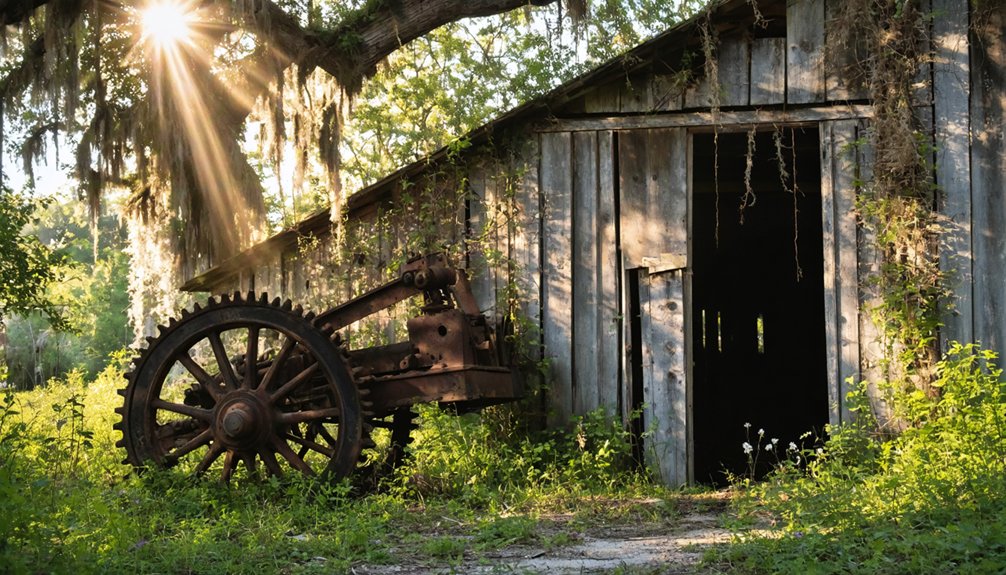
- Pre-arranged guided tours provide deep insights into the plantation’s diverse history, including stories of Acadians, Creoles, and immigrants.
- The general store showcases traditional skills through homemade goods like jellies and pralines.
- Annual spring arts festivals and community events keep cultural traditions alive.
- https://gardevoirci.nicholls.edu/2019/laurel-valley-plantation/
- https://www.louisianahauntedhouses.com/real-haunt/laurel-valley-village-plantation.html
- https://www.tripadvisor.com/Attraction_Review-g40459-d6855935-Reviews-Laurel_Valley_Village-Thibodaux_Louisiana.html
- https://www.laurelvalleyplantation.com/history-of-laurel-valley
- https://www.laurelvalleyplantation.com
- https://www.shreveporttimes.com/story/news/2025/09/04/does-louisiana-have-any-ghost-towns-how-many-are-there-where-to-find-abandoned-towns/85972403007/
- https://en.wikipedia.org/wiki/Laurel_Valley_Sugar_Plantation
- https://www.explorelouisiana.com/historic-districts-sites/laurel-valley-village-plantation
- https://gardevoirci.nicholls.edu/2017/laurel_valley/
- https://www.lacajunbayou.com/things-to-see-and-do/tours-and-attractions/laurel-valley-village-and-sugar-plantation
Frequently Asked Questions
What Are the Current Admission Prices and Hours for Laurel Valley Village?
You’ll pay $17 for adult admission, with special discounts available. Tours run daily at 10 AM and 2 PM, lasting 1.5 hours. The grounds and store are free to visit without a tour.
Are Pets Allowed on Guided Tours of the Plantation?
Like a faithful companion on a journey through time, you’re welcome to bring your leashed dogs on plantation tours at Laurel Valley Village, unlike most historic sites’ stricter pet policies.
Is Photography Permitted Inside the Historic Buildings and Structures?
You’ll need to contact the site directly for current photography policies, as there’s no documented guidance. While interior photography is common at historic preservation sites, specific restrictions aren’t publicly available.
Does the General Store Accept Credit Cards for Purchases?
You’ll want to bring cash, as there’s no confirmed credit card acceptance at the general store. Their volunteer-run operation and historic preservation focus typically favors traditional payment methods.
Are There Handicap-Accessible Facilities and Pathways Throughout the Village?
Like a mixed bag of marbles, handicap accessibility varies throughout. You’ll find wheelchair-accessible parking and restrooms, but historic building access is limited. Village pathways accommodate vehicles for mobility-impaired visitors with advance notice.
